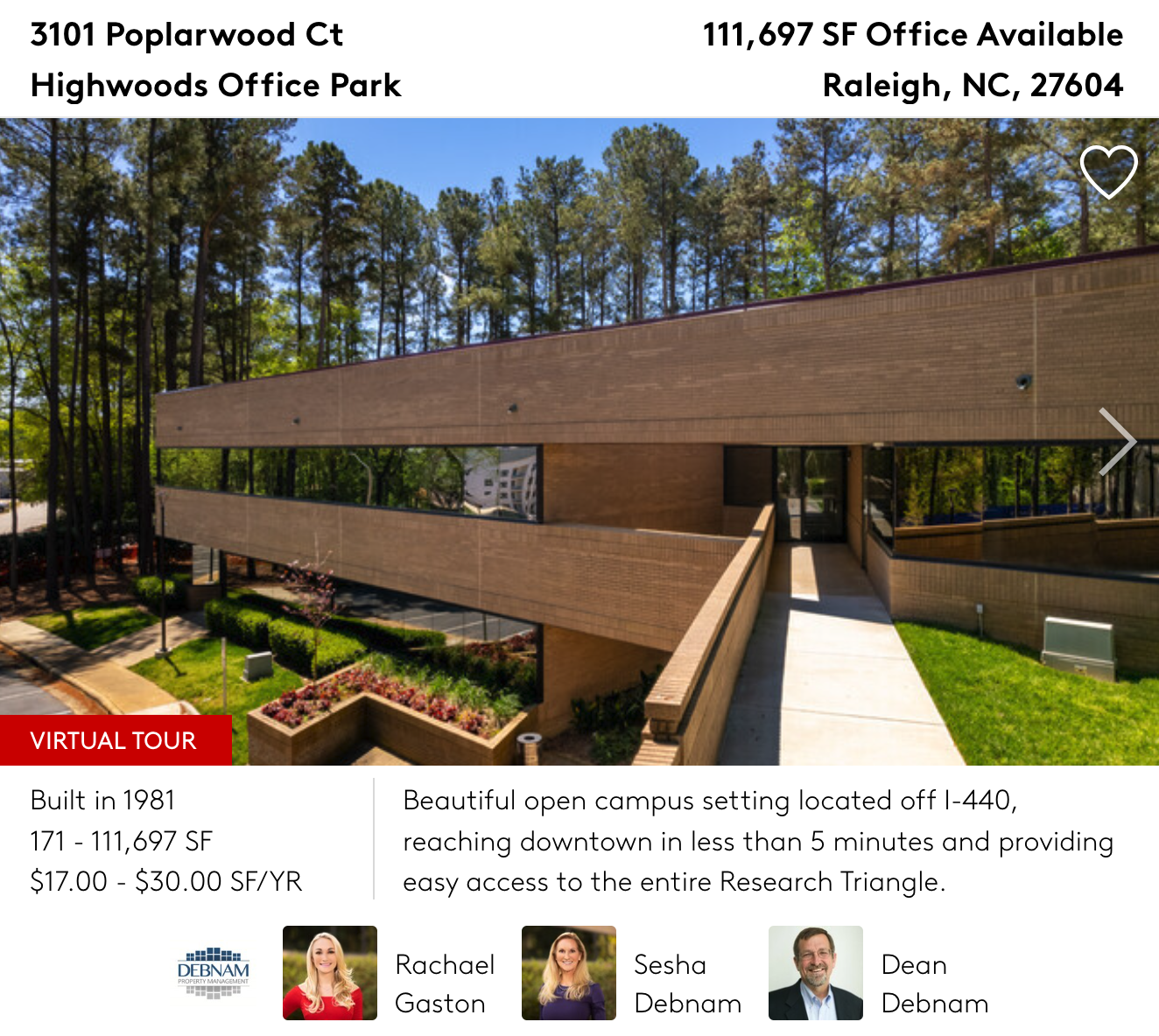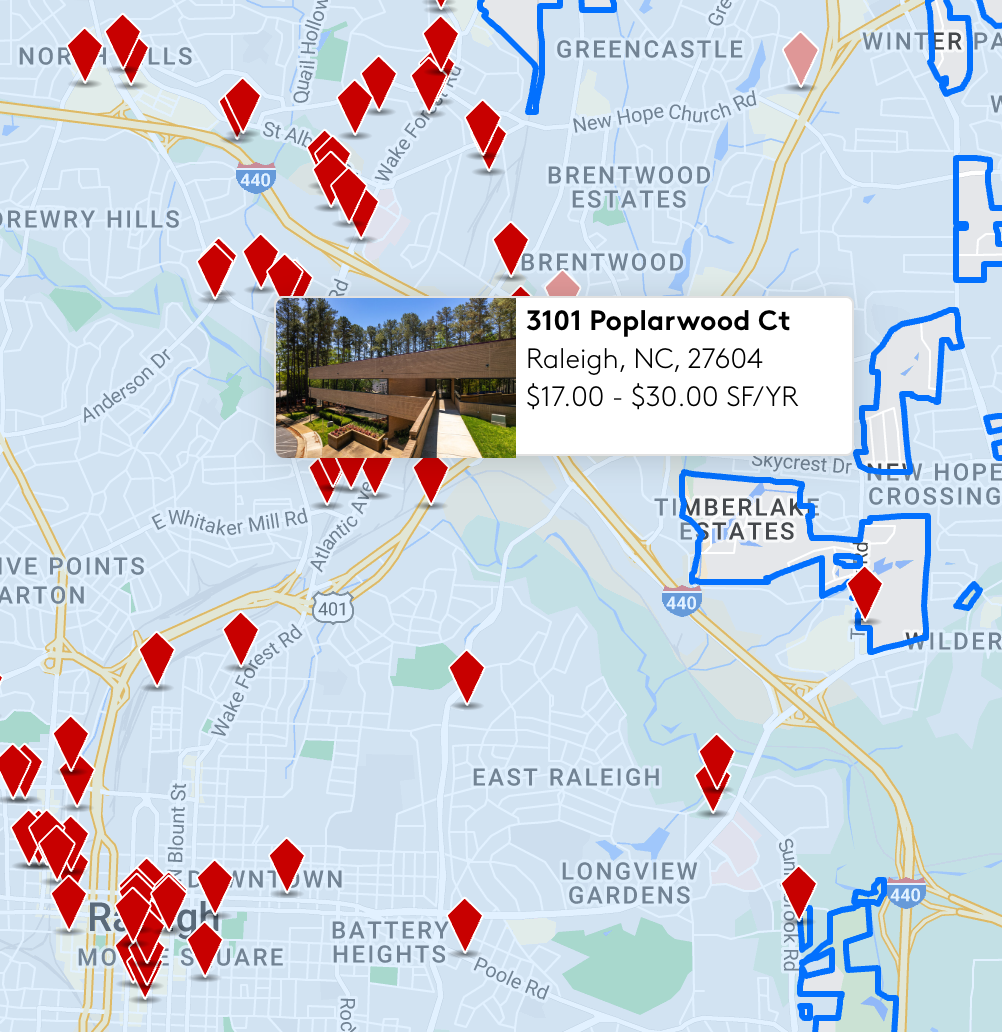Quick Links
In a hurry? No time to read the whole article? Click on the links below to find answers faster.
Finding Commercial Space Online in Raleigh, North Carolina
Finding the right commercial property to lease can be exhausting for tenants. There are lots of options available, and it's essential to know the most effective methods for locating suitable spaces. In this article, we will explore different methods tenants can use to find commercial properties to lease, including online platforms, property management companies, and real estate agents.
LoopNet - This site is helpful for its easy-to-use search engine. Just type in your use (simple dropdown) and the location you want to lease in. You are returned quality results. You get a Google map that shows all the listings in your target area. You get the broker names. And pictures of interiors and exteriors. You also get a virtual tour. It's a real estate marketplace with about 800 new listings added daily. It includes high-resolution photos, 3D tours, floor plans, and researched content. Find LoopNet here.
Avison Young - A brokerage team that specializes in industrial and office spaces in the Raleigh-Durham area. They offer data-driven intelligence and expert insights to help with commercial real estate investment decisions. They offer commercial lease administration services, landlord representation services, and agency leasing services. To save time don't go to their national search page but start here with their Raleigh Durham-specific searches.
- PropertyShark - A website that allows you to search for commercial space to rent or buy in your preferred location.
- CommercialCafe - A website that lists office space for lease or rent in Raleigh, with an average rent of $31.68 per square foot.
- CommercialSearch - A website that lists retail space and commercial real estate in Raleigh, including office, industrial, and vacant land.
- CityFeet - A website that lists commercial real estate for lease in Raleigh, including office, industrial, and retail space
Commercial Real Estate Brokers
These specialists focus on leasing and selling commercial properties. They have access to listings and knowledge of the market, including upcoming vacancies.
ets.
Construction Materials and Techniques
The choice of construction materials and techniques significantly impacts the sustainability, durability, and aesthetic appeal of commercial buildings. Here are some best practices:
Sustainable Materials: Opt for materials that are durable, recyclable, and have a low environmental impact. Bamboo and mass timber are excellent examples of sustainable materials that are gaining popularity in the construction industry.
In the realm of commercial building, achieving energy efficiency is not just a trend but a necessity. The drive towards sustainability has led to the adoption of innovative materials and construction techniques that significantly reduce a building's carbon footprint while enhancing its energy efficiency. This section delves deeper into sustainable materials and innovative techniques, drawing insights from recent advancements and successful case studies.
The choice of materials plays a pivotal role in the sustainability and energy efficiency of commercial buildings. Traditional materials like concrete, steel, and wood have been the backbone of construction for decades. However, the environmental impact of these materials, from production to disposal, has led to a search for greener alternatives.
Green Building Material Replacements: As highlighted by ProptechOS, sustainable materials such as bamboo, mass timber, and recycled content products offer a lower environmental footprint compared to traditional materials. These materials not only reduce the energy consumed during production but also enhance the energy efficiency of the buildings they are used in. For instance, mass timber has gained attention for its carbon sequestering capabilities and its ability to provide the same structural integrity as steel or concrete with a significantly lower environmental impact.
Case Studies of Success: The Bullitt Center in Seattle exemplifies the use of sustainable materials, featuring a wooden frame sourced from responsibly managed forests and a rooftop solar array that meets its energy needs year-round.
-Innovative Techniques: Embrace innovative construction techniques that can improve efficiency and reduce costs. For example, modular construction allows for parts of a building to be prefabricated off-site, reducing waste and speeding up construction times.
Beyond materials, the techniques employed in the construction process can greatly influence a building's energy efficiency. The industry has seen a shift towards methods that not only reduce the time and cost of construction but also minimize the environmental impact.
Passive Design: A cornerstone of energy-efficient construction, passive design leverages the building's orientation, insulation, and natural ventilation to minimize the reliance on artificial heating and cooling systems.
Renewable Energy Systems: The integration of renewable energy sources, such as solar panels and wind turbines, into commercial buildings is a direct route to reducing dependence on fossil fuels.
Building Automation Systems: Modern buildings are increasingly equipped with advanced automation systems that optimize energy use. These systems can control lighting, heating, ventilation, and air conditioning based on occupancy and other variables, significantly reducing energy waste
Technology Integration: Utilize technology to make informed decisions about materials and construction techniques. Software tools can help architects and engineers analyze the performance of different materials and design options, leading to better outcomes.
Design and Layout
The design and layout of a commercial building play a critical role in its functionality, aesthetics, and maintenance requirements. Here are some tips for success:
Open Spaces: Modern commercial buildings often feature open plan layouts, which promote collaboration and flexibility. These spaces can adapt to various uses and are generally easier and less costly to maintain.
Multi-Purpose Spaces: Designing spaces that can serve multiple purposes can maximize the utility of every square foot. This approach reduces wasted space and can lead to significant cost savings over time.
Natural Light: Maximizing natural light not only reduces the need for artificial lighting but also creates a more pleasant and productive environment for occupants. Consider the placement of windows and the orientation of the building to take full advantage of natural light.
Maintenance Strategies
Maintaining a commercial building is an ongoing challenge that requires strategic planning. Here are some insider tips for low-maintenance commercial properties:
Low-Maintenance Materials: Choose materials that are durable and easy to clean. For example, high-quality metal roofing can last decades with minimal maintenance, while certain types of flooring can withstand heavy traffic without frequent repairs.
Preventative Maintenance: Implement a regular maintenance schedule for all critical systems, especially HVAC. Preventative maintenance can identify and address potential issues before they become major problems, saving time and money in the long run.
Energy Audits: Conduct regular energy audits to identify areas where energy efficiency can be improved. This can involve upgrading insulation, sealing leaks, or updating lighting and HVAC systems to more energy-efficient models.
Conclusion
Success in commercial building projects requires a holistic approach that considers energy efficiency, construction materials, design and layout, and maintenance strategies. By implementing the insider tips outlined in this article, developers, architects, and building managers can create commercial buildings that are not only aesthetically pleasing and functional but also sustainable and cost-effective in the long run. The key is to stay informed about the latest trends and technologies in the industry and to prioritize decisions that add long-term value to the property.
The best method often depends on the size and complexity of your needs. For smaller spaces, searching online listings or driving around your target area might be sufficient. For complex needs or highly competitive markets, a commercial real estate broker can be a valuable asset.
Get an Estimate
Here is our simple estimate form. Fill it out the best you can, keeping in mind these tips to get the most accurate estimate.
1. Project Details:
Please provide a brief project description, including scope, size, and specifics (if possible).
2. Timeline:
Discuss your expected timeline for the project.
3. Site Information:
Please share some details about the site where the project will be executed. This could include the location, accessibility, local regulations, and any site-specific challenges you foresee.
4. Communication:
Please provide a brief project description, including scope, size, and specifics (if possible). Communicate openly with the architect throughout the estimation process to address any questions or concerns they may have.






